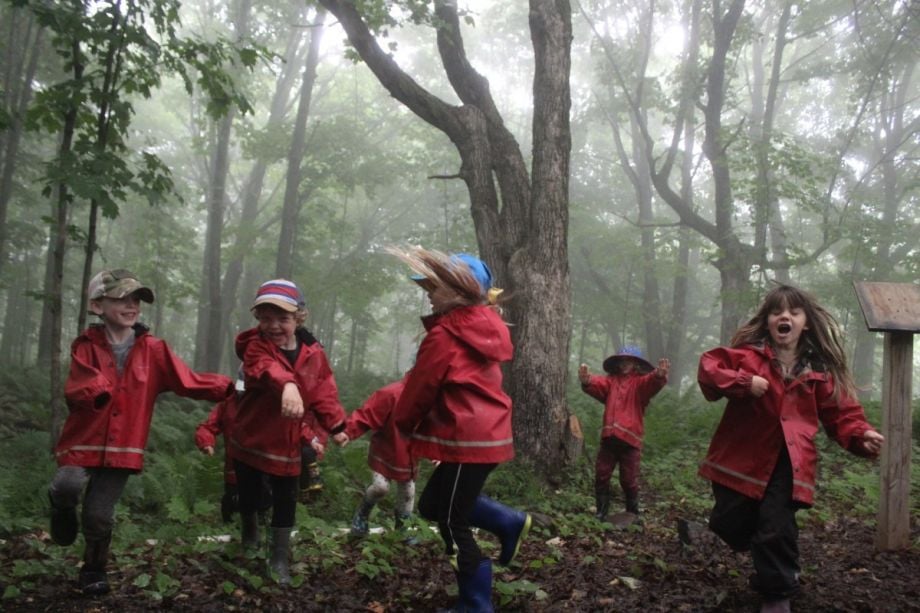When Meghan Morrow, then a sign language interpreter, would drop her two-year-old son off at daycare back in the 2010s, all he wanted to do was play outside. “As I was dropping him off at childcare, he would sign ‘outside’,” she recalls. Back home at the end of the day, “all he wanted to do was be outside.”
Morrow was overjoyed that her son obviously shared her love for the outdoors, which is what had driven her to Duluth in the first place. But it brought up challenges, too. “As he got old enough to communicate with me and sign, I knew that was something he also valued as well,” she says. “As a parent I was really proud that we had instilled that in him, but I was also very disappointed that there wasn’t a program that encapsulated this lifestyle for young kids.”
Morrow started doing some research and came across a Scandinavian approach to learning outdoors called udeskole, or “outside school.” Considering Minnesota’s deeply Scandinavian roots, Morrow was surprised an outdoor-based and nature-focused preschool didn’t exist in the area already. So, “I held my breath and crossed my fingers that I wasn’t the only parent in the area that valued those things for our little humans,” and she started Secret Forest Play School in the fall of 2012.
Located on a roughly 20-acre plot of forested Ojibwe land now owned by a local church and housed in a cabin-like secondary building centered around a custom glass garage door, Secret Forest focuses on nature as a catalyst for curiosity and the social and emotional learning that accompanies it. It’s one of about 10 nature-based programs that have opened in the Duluth area; all have waiting lists, according to MPR News.
“I work with 20 kids a year on a two-year cycle,” Morrow explains. One class of 10 kids comes to Secret Forest on Mondays and Wednesdays while another cohort attends on Tuesdays and Thursdays. “When they come as 3-year-olds, I call them my seeds. In their second year, they’re considered sprouts. Then, at 5, my sprouts head off to kindergarten as saplings.”
Preschools like this that focus on social and emotional skills more than academics speak to a lot of parents, explains Christy Merrick, the director of the Natural Start Alliance, a network of people and organizations that support nature-based education. While Native Americans and other Indigenous groups had been educating outdoors for centuries, this approach to learning began growing in popularity in the United States in the 1960s, a trend that continues today.
A 2020 report from Natural Start found that the number of nature-based preschools had doubled to 585 between 2018 and 2020. As such schools have increased, researchers have begun to examine the academic performance of students in such learning environments. “The findings across the board have been really consistent, that children who go to these schools are well prepared for kindergarten,” Merrick says. “They’re not behind their counterparts who might have come from a more academic program.”
Thanks to the focus on nature over arithmetic, there’s no truly typical day at Secret Forest, but most days start with arrival at the garden where the kids plant seeds and water the plants as drop offs occur. When it’s warm enough, snacktime becomes an outdoor picnic. During community time, the group comes together to check in with each other and discuss things like the current moon phase. Next, after a story is read, the group starts down a half-mile trail into the forest. Nap time takes place at Hammock Village until the temperatures drop and the event moves into the wood stove-heated cabin.
All along the way are play destinations — nothing that would catch most adults’ attention, but this is where most of Secret Forest students’ real learning and play happens.
“It’s where they build their forts and collect dandelions,” Morrow says. “That’s when they use their imaginations, where they climb and jump and build this resilience and confidence and toughness about them. They learn to self-regulate and get a chance to learn to lead and follow. We talk to them about being helpers and healers.”
While space might not be as much of an issue for an outdoor-focused school, in northern Minnesota, the right gear is.
“The quality of gear varies and the cost of quality gear can be a barrier or a burden for families, especially with growing children,” Morrow says. So with the $335 monthly cost of enrollment, gear — rain jackets and parkas, snow pants and rain pants, winter and wet mittens — is included.
Down the line, Morrow hopes to be able to improve accessibility to the physical location, which is a 10-minute drive from Duluth.
“We’re on the north side of town and aren’t on a bus route, so we’re not as accessible as I’d like to be for a diverse community,” she says. It can be particularly difficult for families that need longer hours for care beyond the program’s 4:30 p.m. stop time.
With such constraints complicating access to cost-prohibitive private schools, Morrow believes preschoolers and beyond can benefit from more nature-based school integration into the public school system.
“There are now some of these programs in our public schools and these are the programs that can reach the broadest audiences because they’re free,” Morrow adds. Last year, three pubic elementary schools in Duluth received new nature playscapes. “It’s really wonderful to see this happening in public programs, not just private programs.”

Cinnamon Janzer is a freelance journalist based in Minneapolis. Her work has appeared in National Geographic, U.S. News & World Report, Rewire.news, and more. She holds an MA in Social Design, with a specialization in intervention design, from the Maryland Institute College of Art and a BA in Cultural Anthropology and Fine Art from the University of Minnesota, Twin Cities.
Follow Cinnamon .(JavaScript must be enabled to view this email address)








